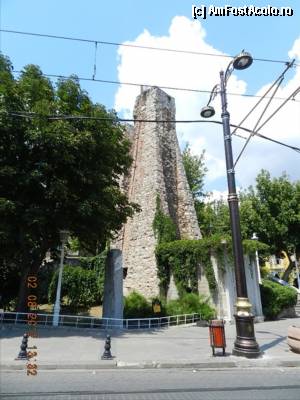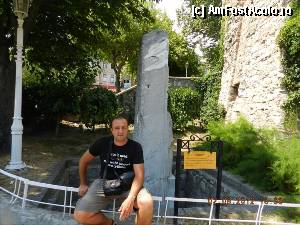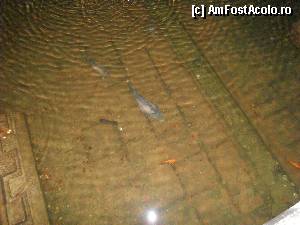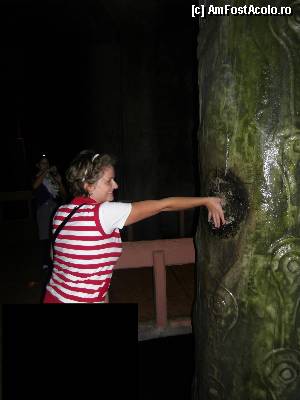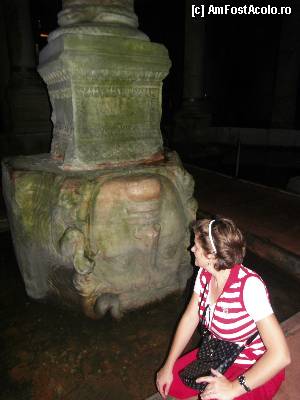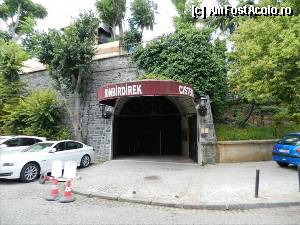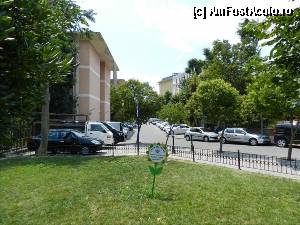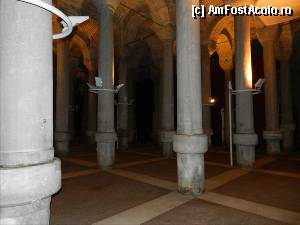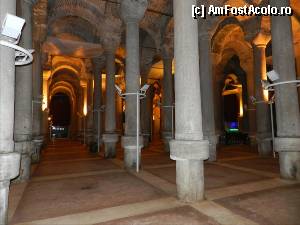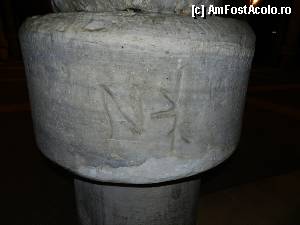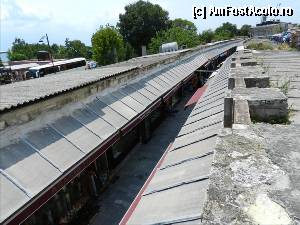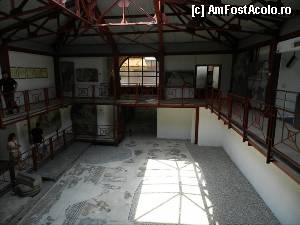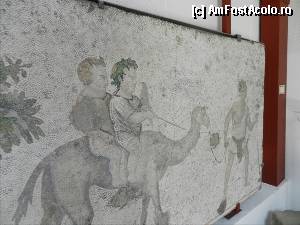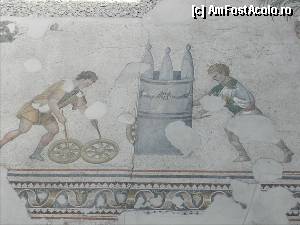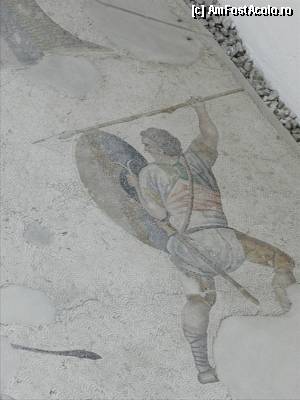GRAD SATISFACȚIE
NOTARE MEDIE REZULTATĂ
In una din vizitele mele recente la Istanbul – 17 Iulie 2012, mai precis, incercasem sa ajung la Rahmi Koç Museum despre care am vorbit aici si dadusem gres. Deoarece inca eram in Eminönü si nu prea aveam mult timp de alte cele pana la avion m-am gandit sa incerc sa vad ce mai pot descoperi prin orasul vechi.
Am citit cateva ghiduri (si carti mai vechi) despre Istanbul si toate au cate ceva diferit. Un ghid destul de reusit este Frommer’s Istanbul. Mi-a atras atentia in special un Walking Tour al lor, care se numeste Istanbulul Subteran sau “Istanbul Underground”. Acest walking tour se poate gasi online si pe pagina lor oficiala aici frommers.com/destinations ... 0350020034.html. Am sa atasez si harta pe care am copiat-o de la Google Books Preview, pentru o orientare in spatiu mai usoara.
Orase noi, construite peste orase vechi - cam asta e ideea reviewului... Norocul nostru este ca orasele vechi mai ies la suprafata din cand in cand :)
Am sa folosesc numerele de pe harta celor de la Frommer's si am sa vorbesc despre locurile pe care am reusit sa le vad din lista lor.
Am sarit peste vizita la:
1. Cisterna Basilica; Yerebatan Sarnıçı (Cisterna Scufundata) i se mai zice si Palatul Scufundat;
deoarece o vazusem deja de vreo doua-trei ori. Am sa atasez cateva poze mai vechi.
A scris despre el si @Diaura in acest review – “Palatul Scufundat (Yerebatan Serai) ”
Asta este cel mai renumit si o vizita la el, nu ar trebui ratata, mai ales ca-i in imediata apropiera a Hagiei Sofia. Intrarea o gasiti in parculetul din stanga al Hagiei Sofia. Privind la catedrala, mergeti in partea stanga a ei si treceti drumul, exact in curba si veti gasi intrarea intr-un fel de mini parc.
Tot in aceasta curba in acel parc se afla si Piatra Million. Citisem de foarte multe ori despre aceasta piatra dar niciodata nu reusisem sa o localizez :) Trecusem pe langa ea de foarte multe ori.
Toti stim zicala “Toate drumurile duc la Roma” – asta se datoreaza si faptului ca in Roma exista un monument similar, numit “Milliarium Aureum” de la care se masura distanta pe toate drumurile care plecau in Imperiu. Cand Constantin si-a contruit noul imperiu, ombilicul lumii s-a mutat aici. Asta a devenit noul “Ground Zero”... cum s-ar zice. Doar aceasta piatra a mai ramas din cladirea care marca acest loc.
Am vazut un documentar care mi-a deschis putin ochii (intr-un mod in care nu ma asteptam) despre importanta strategica a Constantinopolelui. Sa ne amintim ca Constantin s-a intors tocmai din Anglia de la York, pentru a veni sa se lupte cu Maxentius si a strabatut imperiul dintr-un capat in altul, iar in tinerete s-a luptat cu mai multe triburi barbare de prin Germania. Imperiul Roman de Apus, era in permanenta atacat de triburile barbare din nord si trebuiau sa tina mereu cateva legiuni la granitele dinspre Nord.
Mutand capitala la Constantinopole, Constantin nu avea doar un port natural (Cornul de Aur), controland in acelasi timp intrarea si iesirea in Marea Neagra, dar avea si cheile intrarii in Asia. Cele mai importante orase ale romanilor se aflau in ceea ce astazi este Turcia si Orientul Apropiat. Din sud nu prea ii pasteau pericole deoarece in cateva locuri il protejau deserturile si nici nu exista o forta militara care sa le puna probleme pe atunci. Cele mai multe amenintari planau din Nord. Singura problema cu locatia era ca nu existau surse de apa potabila. Romanii au trebuit sa construiasca numeroase apeducte care sa aduca apa de la izvoarele din afara orasului si cisterne in care sa o depoziteze.
Cisterna Scufundata era una dintre cele mai mari, avand suprafata a doua terenuri de fotbal si 336 de coloane de marmura care sustineau tavanul de caramizi. Cu timpul otomanii au uitat de ea, si s-au construit case deasupra si toti se minunau cat de norocosi sunt cei care locuiesc in aceste case, deoarece doar fac o gaura-n pamant si dau de apa. Cand a fost redescoperita, era pe jumatate plina si turistii de pe la 1800 si ceva puteau face plimbari cu barca. :)
De cand a fost deschisa ca muzeu, s-a lasat putina apa pe fund in care inoata cativa crapi si se circula pe niste pasarele de lemn. La construirea cisternei, s-au folosit coloane de la veche temple pagane (nu mai era nevoie de ele... acum erau crestini). Pe la mijlocul cisternei, in dreapta veti gasi “Coloana cu Ochi de Paun”. Asta, ca si “Coloana care Transpira” din Sf. Sofia, are o gaura in ea, in care e vorba ca pui degetul mare si daca poti invarti celelate degete sa faca un 360 de grade, ti se indeplineste o dorinta.
Inainte de iesire in stanga, mai sunt si doua capete de Meduza.
Aceasta cisterna este cea mai renumita si cea pe care nu ar trebui sa o ratati daca sunteti la prima vizita. Nu este insa singura.
Ca sa raman in aceasta zona... am sa atasez o poza cu acoperisul uneia care o gasiti cand mergeti inspre Topkapı. Trece trotuarul peste ea... si au lasat o bucata neacoperita, pentru a o arata turistilor. Nu se poate vizita in interior.
Am mers insa la una care se poate vizita in interior:
2. Cisterna Philoxenus; sau Binbirdirek Sarnıçı. Numele turcesc se traduce prin “Cisterna Celor O Mie Una de Coloane”
Desi aveam harta, am avut probleme sa o gasesc, desi ar fi trebuit sa fie foarte usor.
Mergand prin parcul din partea stanga a Divan Yolu, inspre Çemberlitaş, o veti gasi in stanga, cum se termina parcul. In stanga se vede o cladire mare, vopsita in roz care e Palatul de Justitie si e peste drum de ea.
Eu iesisem din parc, si urcasem dealul si m-am invartit de mai multe ori pe acolo pana sa o gasesc. Am intrebat pe mai multi... dar nici unul nu avea habar. Simteam ca sunt aproape deoarece numele de Binbirdirek... aparea in mai multe locuri. Deasupra Cisternei este o parcare de masini... si cand l-am intrebat pe cel care avea grija de masini unde e Cisterna Celor O mie Una de Coloane... mi-a zis: “Stai pe ea! ” :) Nu m-am gandit ca au amenajat o parcare de masini pe un monument vechi de peste 1700 de ani. A trebuit sa cobor in parc ca sa gasesc intrarea.
Costul intrarii a fost de 5 TL.
Au si o pagina destul de bine pusa la punct aici binbirdirek.com
Aceasta este una dintre cele mai vechi cisterne din Istanbul si a fost construita de Philoxenes, un senator roman pe care Constantin l-a obligat sa se mute in noua sa capitala. E vorba ca apa din cisterna era pentru Palatul lui Philoxenes sau Palatul Lavsus, aflat undeva in apropiere.
Cu trecerea timpului, a secat iar otomanii au folosit-o pentru ateliere ce lucrau cu viermi de matase. Intr-un timp a mai functionat ca depozit.
Cisterna are 224 de coloane (de unde pana unde cu 1001? - se zice ca e o greaseala de nume "binbir" inseamna 1001 si "bindir" - una peste alta; se banuieste ca numele otoman era "bindir", deoarece sunt coloane una peste alta si s-a gresit... ca la telefonul fara fir), si era mult mai inalta decat Basilica Cisterna. Doua coloane erau puse una peste alta si unite la mijloc de un brau de marmura, ca sa atinga inaltimea de 15 m. Mai apoi acest loc a devenit un loc pentru aruncarea gunoaielor. Se facusera mai multe gauri in tavan pentru intrarea luminii, si locuitorii Istanbulului au inceput sa arunce gunoaie inauntru. Au trebuit 7 ani pentru curatenie si 7000 de camione de gunoaie au fost scoase din aceasta cisterna.
Coloanele nu au fost curatate pana la baza si astazi se viziteaza la nivelul unde cele doua coloane se imbina. Pe fiecare coloana este cate o litera si se banuieste ca sunt insemnele mesterilor care le-au facut.
Aceasta cisterna este fara apa... doar intr-un singur loc este sapat un fel de bazin, in care inoata cativa pesti - aratand adevaratul nivel al cisternei. Se tin fel de fel de spectacole si expozitii aici. Cealalta cisterna ar trebui sa fie pe primul loc, dar a fost interasanta vizita si la aceasta.
Dupa ce am vizitat Binbirdirek, nu am mai avut rabdare sa caut si celelalte mentionate de Frommer’s si am sarit direct la:
6. Muzeul de Mozaicuri al Marelui Palat
en.wikipedia.org/wiki/Gre ... e_Mosaic_Museum
Costuri – 8 TL
Deschis: 9:00-19:00 vara si 9:00-17:00 iarna. Inchis Luni.
Locatia in Arasta Bazaar, cum veniti la Moschee Albastra, undeva in stanga. Din curtea Moschei Albastre sunt indicatoare.
Acest muzeu incercasem sa-l vizitez prin Ianuarie, dar atunci il gasisem inchis, deoarece au avut loc renovari la acoperis. Nu mi-a parut rau ca l-am vizitat acum. Cred ca e un Must See in zona Sultanahmet si nu ar trebui ratat.
Aici era locul unde era Palatul lui Constantin cel Mare. Moscheea Albastra a fost construita peste Palatul lui Constantin si o bucata din Hipodrom. Din cate am inteles, palatul era conectat direct cu Hipodromul, pe atunci sintagma fiind: “Am mintit poporul cu... hipodromul”: P
Unele dintre cele mai frumoase mozaicuri impodobeau podelele si peretii palatului si sunt in foarte buna conditie si acum. Este incredibil ce au putut face cu pietricele si bucatele de sticla si frumusetea acestor mozaicuri. Doar o mica parte din palat a fost dezgropata.
Nu vreau sa ma lungesc prea mult. Sfatul meu e sa nu ratati acest muzeu. Eu cel putin am fost incantat si cred ca e una din cele mai frumoase colectii de mozaicuri pe care le-am vazut. O sa vedeti in poze. Mozaicuri cu animale, oameni etc. Cele cu animale sunt deosebite si arata cunostiinte destul de bune ale romanilor despre animale ca tigri, elefanti, lei... etc. Sfera povestilor nu lipseste insa si gasim si lei inaripati si cu cioc.
Prin zona asta sunt multe magazine cu covoare turcesti si multe prostii pentru turisti. Sunt cateva magazine care au cisterne pe la subsol dar nu mai aveam timp sa le vizitez, deoarece trebuia sa ma intorc in Taksim. Am trecut pe langa Sf. Sofia si am mers sa vad drumul Isak Pasha. Acest pasha fiind un grec, iar drumul din spatele Sf. Sofia e foarte frumos cu mai multe case in stil otoman.
Coborand inspre Gülhane si intrarea la Muzeele Arhelogice, am trecut pe langa un alt obiectiv mentionat de cei de la Frommer:
9. Restaurantul Sarnıç ("Sarnıç" inseamna "cisterna" in turceste)
E un restaurant construit intr-o veche cisterna bizantina veche de peste 1600 de ani. Acest loc a fost intr-un timp folosit ca atelier auto... :) Proprietarul actual a cumparat locul, a facut curat si a amenajat un restaurant. Singurul lucru mai nou, e un semineu. Nu am facut poze inauntru... dar e interesant de vazut. Nu se plateste intrare... dar s-ar putea sa nu va lase sa vizitati. Depinde de garçon. Seara au lumanari si muzica live... trebuie sa fie frumos.
Un alt obiectiv pe care am reusit sa-l bifez din acest tur a fost:
10. Yeraltı Camii – sau Moscheea Subterana
Se trece Podul Galata, in Karakoy si e undeva in dreapta inspre mare. Aceasta moschee a fost amenajata intre anii 1753-1756, in cripta unui vechi Castel Genovez - numit Castelul Galata, construit aici intre anii 1166-1169.
Se spune ca aici undeva era ancorat marele lant, care inchidea intrarea in Cornul de Aur. Dupa cucerirea otomana, ramasitele castelului nu au fost folosite – sau au fost folosite ca depozit pentru praf de pusca, deoarece un alt nume al Moscheii este Mahzen Camii (Moscheea Prafului de Pusca) , dar apoi un derviş musulman, a avut un vis cum ca doi sfinti arabi care au murit in asaltul arabilor asupra Constantinopolelui ar fi ingropati aici. Cand niste ramasite omenesti au fost gasite in cripta Castelului Galata, locul a fost amenajat intr-o moschee. Sunt doua locuri in peretii laterali unde au fost amenajate mormintele celor doi.
Este una dintre cele mai ciudate moschei pe care am vizitat-o.
Intrarea este libera, (trebuie sa va descaltati la intrare) si sunt mai multi oameni la rugaciune. Peretii au fost toti varuiti in alb, iar covorul are cate o patratica pentru fiecare si indica directia in care trebuie sa se roage.
Am gasit un colt unde nu erau multi credinciosi si am putut fura cateva poze. Ne putem imagina ce puternic era castelul genovezilor, care fusese candva aici, dupa grosimea zidurilor. E un loc interesant de vazut.
Din lista celor de la Frommer’s, ar mai fi:
11. Tünel
Funicularul care urca pana pe Istiklal Caddesi – construit in 1876. Unul printre primele de acest gen din lume.
Cam atat am reusit sa vad din lista celor de la Frommers, sper sa merg sa caut si celelalte obiective in viitor. Sper ca pozele sa aduca un plus de informare la acest review. Sunt multe alte locuri subterane din Istanbul care asteapta sa fie vizitate sau redescoperite.
Dintre cele care am vorbit, cel mai mult recomand Muzeul Mozaicurilor.
Sarbatori fericite tuturor membrilor AFA si un an nou cat mai bun.
AmFostAcolo fără reclame?
- Utilizatoriii LOGAȚI văd o versiune cu mai puține reclame
- Ai dori o versiune COMPLET fără reclame? — devino membru afaFanClub -- citește mai mult
Trimis de TraianS in 20.12.12 12:33:41
13 ecouri scrise, până acum, la acest articol
NOTĂ: Părerile și recomandările din articol aparțin integral autorului (TraianS); în lipsa unor alte precizări explicite, ele nu pot fi considerate recomandări sau contrarecomandări din partea site-ului AmFostAcolo.ro („AFA”) sau ale administratorilor.
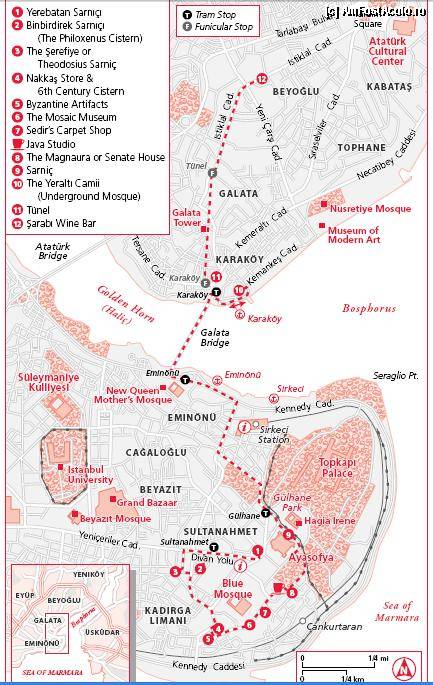
ECOURI la acest articol
13 ecouri scrise, până acum, la acest articol
Articolul a fost selectat ca MiniGhid AmFostAcolo pentru această destinaţie.
Din ciclul "Istanbulul mai puţin cunoscut"... Traian ne arată că adevăratul turist-descoperitor de frumuseţi trebuie să aibă şi o genă de arheolog, să coboare şi-n catacombe deoarece obiectivele de interes nu se află doar la... parter.
Merry Christmas!
Un articol deosebit de interesant, cu fotografii elocvente!
Sarbatori fericite si... magice, alaturi de cei dragi!
@TraianS: Ce chef imi faci de Turcia, draga Traian... Eu am fost de doua ori, in 99, si sper sa pot planui in viitorul nu foarte indepartat o "revedere"... E grozava partea asta mai ascunsa a orasului, a tuturor locurilor in general...
Va urez si eu Sarbatori Fericite si un an nou cu multe calatorii sprancenate!! (s-a legat Japonia aia? ![]() )
)
P.S. Ce-ai "ascuns" in P07?
Articolul a "primit" o ilustraţie muzicală sau video-muzicală - vezi mai sus, imediat sub titlu.
Daca autorul preferă o altă melodie sau un alt videoclip, este rugat să ne scrie (aici, ca ecou, ori pe PM)
@TraianS: Frumos review si de folos celor ce vizitand Istanbulul vor dori sa vada si altceva decat Moscheea Albastra, Sfanta Sofia si cele doua palate marete.
Si din partea noastra un an nou fericit, cu impliniri si toate cele bune alaturi de cei dragi!
Foarte interesante obiective, iar Istanbulul pare un oras de neratat. Nu mai vorbesc de maiestria ghidului iubitor de istorie!
@le_maitre
Mersi de ecou ![]() Nu am coborat eu la cine stie ce mare adancime... dar imi place sa incerc sa descopar astfel de locuri. E un fel de treasure hunt
Nu am coborat eu la cine stie ce mare adancime... dar imi place sa incerc sa descopar astfel de locuri. E un fel de treasure hunt ![]() . Multe din lista celor de la Frommer's nu le-am facut inca, deoarece nu sunt locuri deschise special turistilor. Unul e subsolul unui magazin de covoare (trebuie sa cazi la pace cu proprietarul sa te lase sa vizitezi) altul e nu stiu ce depozit etc. Le-am facut pe cele mai usoare si mai accesibile intai.
. Multe din lista celor de la Frommer's nu le-am facut inca, deoarece nu sunt locuri deschise special turistilor. Unul e subsolul unui magazin de covoare (trebuie sa cazi la pace cu proprietarul sa te lase sa vizitezi) altul e nu stiu ce depozit etc. Le-am facut pe cele mai usoare si mai accesibile intai.
Unele inca nici nu le-am mentionat - cum ar fi "Inchisoarea lui Anemas" de exemplu, care inca nu a fost complet excavata si are o moschee de a lui Sinan deasupra. Oriunde ai sapa in Istanbul, dai peste ceva. De exemplu citisem intr-un ziar, ca lucrasera la nu stiu ce tevi in gradina Moscheii Albastre si gasisera o bucata (mare) de banca de marmura care facuse parte din Hipodrom. O mare parte din palatele bizantine si hipodrom se afla inca sub Moscheea Albastra. Cu timpul poate mai iese cate ceva la iveala.
Anyway, bine ca a trecut Apocalipsa pe jumate si ne asteapta Craciunul. Sarbatori fericite tie si familionului tau si sper ca negocierile cu Mos Craciun au decurs cat mai bine. ![]()
@Marian Preda
Multumesc pentru ecou. ![]() Am citit cu placere impresiile tale despre China si am sa le iau la recitit mai pe indelete cand ma pot concentra mai bine, ca acum imi zboara fel de fel de cisterne, minarete si alte nazbatii prin cap
Am citit cu placere impresiile tale despre China si am sa le iau la recitit mai pe indelete cand ma pot concentra mai bine, ca acum imi zboara fel de fel de cisterne, minarete si alte nazbatii prin cap ![]() Sarbatori cat mai frumoase alaturi de cei dragi.
Sarbatori cat mai frumoase alaturi de cei dragi.
@alinaro
Unele lucruri cred ca le vei gasi diferite fata de '99. Cred ca va fi o vizita interesanta, dupa atatia ani. ![]()
Sarbatori cat mai fericite cu multe colinzi! ![]()
P. S. Cat despre P07 (felicitari pentru spiritul de observatie, by the way), imi vin in minte cuvintele Celui de-al Saselea Imam, Ja'far al-Sadiq (si ca sa vezi comedie stia engleza baietul):
"Our cause is a secret within a secret, a secret that only another secret can explain; it is a secret about a secret that is veiled by a secret. " ![]()
@webmaster13
Foarte potrivita melodia. Multumesc. Darbuka si ecouri... cea mai indicata muzica pentru astfel de locuri. ![]()
@iulianic
Sf. Sofia am vizitat-o de cateva ori, dar inca nu am prins curajul sa scriu despre ea. Mai trebuie sa o vad de cateva ori si apoi poate, poate... ![]()
Sunt interesante si celelalte locuri mai ascunse ale Istanbulului.
Salutari si sarbatori fericite! ![]()
@nickro
Multumesc pentru ecou si sa stii ca astept sa citesc reviewurile tale despre Istanbul. Sper ca am reusit sa-ti trezesc interesul. ![]()
Un istoric adevarat m-ar face harcea-parcea in doua miscari, sunt sigur ca am facut destule greseli, dar nah... incercam sa mai descoperim si noi cate una alta. Am inceput sa am o imagine (foarte putin conturata) a Constantinopolelui de pe vremuri. Inca mai lucrez la ea.
Iti doresc sa ai parte de sarbatori fericite alaturi de familie si sa planificati cat mai multe calatorii pentru noul an.
---
@all
Vreau sa pun un articol de al lui Umberto Eco in acest ecou. Un articol care mie mi-a placut mult. Mi-e frica sa nu se piarda de pe net, in viitor. Sper ca acei ce vor merge la Istanbul il vor gasi interesant. Articolul e luat de aici:
Istanbul as Unity and Trinity - Umberto Eco
The "Story of the Slave and the Warrior" in Jorge Louis Borges’ Aleph has a character called Droctulft, a barbarian from Lombardy who arrives with his tribe to besiege and capture Ravenna one day. Droctulft comes from the forests of his country, he is "brave, innocent and ruthless, " the only kind of settlement he knows of are the huts in the forest and he now sees a city for the first time.
We may imagine him watching the city walls, towers and other things that he had never seen before as Ravenna slowly emerges on the horizon. As Borges recounts, he encounters the cypresses and marbles of the city, the integrity of a large number of elements that have come together without causing disorder, an organization consisting of regular and open spaces with its statutes, temples, gardens, columns and capitals. Not having known refinement before yet endowed in the recesses of his soul with the immortal gift of discernment, Droctulft notices a kind of complex process. He kneels instantly and indicates his defeat in front of the "thing" he come to conquer and destroy. Droctulft is hit by the unexpected surprise of the "the city, " abandons his tribe and fights (and dies) for Ravenna.
I believe that coming to Istanbul after reading innumerable books about the city would reproduce the astonishment of this mythical Lombardian. (For a long time, the voyage to Istanbul has constituted a literary genre with its own rules and the arrival is always predicated on speed.) Perhaps the reason for this is that some cities resist being described from afar and then suddenly draw one in (London, Rome and Paris) while others reveal themselves gradually without reservation (New York may be considered as such). Istanbul undoubtedly belongs to the second category. At least for those who come from the sea -as it once used to be customary... Whether the boat comes from the Strait of Istanbul or Çanakkale, it passes by the Golden Horn and reveals the city from different perspectives through a kind of cinematographic displacement.
Perhaps the most cinematographic among all descriptions of Istanbul is the one by Nerval, who is little known worldwide. His is followed by those of Gautier, Flaubert, Loti and Edmondo de Amicis. All adolescents in Italy (at least from 1886 up to my generation) were raised on De Amicis’ A Child’s Heart, a thought-provoking book charged with positive emotions. Besides being a good author, De Amicis was a good journalist as attested by his book Constantinopoli (1874). De Amicis’ little-known, lovely interview accompanied me on my first trip to Istanbul.
Like De Amicis, I had postponed this trip for years out of different and totally unexpected reasons. I continued to imagine this city through photographs, engravings, paintings, stories and even old maps. There are cities that are understood through a coincidence. Others require a long period of preparation and can be grasped through a mixture of in-depth knowledge and the imagination. Perhaps many visited Istanbul to discover it. This is why I had to excavate like an archaeologist to unearth the real city again, I had to process and use what I found below this personal Istanbul.
Another requirement is to excavate what others have found... This is why I had De Amicis’ text ready when I came to Istanbul. For he had seen what I cannot see today. First of all, De Amicis comes from the sea. On the last night of the nine-day boat journey, he makes a thorough mystical preparation when he hears the captain announce, "Gentlemen! Tomorrow at dawn, we will see the first minarets of Istanbul. " Passenger De Amicis sleeps little, goes to the deck as soon as he sees the faint light heralding dawn and curses in disillusionment, for there is fog.
But the captain comforts him. The fog will enhance the beauty of entering Istanbul. The Prince’s Islands are distinguished in the direction of the boat’s bow, and given the speed of those times, there are two more tiresome hours before they can see Istanbul. They approach the city enjoying every moment. After a sea journey of one hour the captain points to a white dot, the tip of a very high minaret. Then, the shapes and colors of houses are gradually perceived below the minaret, the pointed tips of other minarets tinged with a rosy color, the city walls below the houses and their dark towers are slowly discerned, but the houses stretch in an interminable row and the city appears to spread over a plain. And then, amidst the fog; "a huge shadow still covered with a layer of fog, a very large, graceful and imposing building rose toward the sky from the top of a hill, it rounded out magnificently in the middle of four very long and thin minarets whose tips glistened like silver under the first rays of the sun. " This was the Hagia Sophia and to suddenly see it rise in the void must have been beautiful...
At this point the unexpected surprise facing them continues, new towers and new domes, again colorful houses above bright houses are revealed in the morning mist, jagged and capricious, white, green, pink and glittering shores emerge. But fog still blocks entry to the Bosphorus and the boat has to stop. This gives the passenger the opportunity to observe the city acting single-handedly to shake off the fog still covering it. At the end, the ship starts again and from below the Palace hill, listening to the symphony of cypresses, firs and plane trees, it passes by the roofs of mansions and annexes, domes, grated windows, arabesque doors barely perceptible through binoculars, labyrinthine gardens, passages and secret corners that the passenger tries to understand.
It is unnecessary for me to repeat page after page of what De Amicis wrote about this arrival; the sudden appearance of Üsküdar in the sunlight, the bright image of Galata and Pera, the symphony of little houses with thousand colors, clusters of trees and "small harbors, seaside mansions, summer palaces, groves, other barely perceptible villages only whose roofs glistening in the sun can be seen amidst the distant fog, a medley of colors that makes one want to shout with joy, a botanical wealth, something not thought of before, a grandeur, a pleasure, a grace... "
I was unable to see this Konstantinopolis because I came to the city from inside. For as I crossed the Marmara Sea by ship from the Asian shore, at the moment that the city flashed in front of my eyes, it was the middle of the day and there was no fog. (During my stay there was only one sunny day, I saw Istanbul immersed in light, the green of the gardens and the hills tinged with the color of gold only for one day.) For if there had been fog, as it slowly dispersed, it would have revealed not streets and villages but the coexistence of domes, minarets and other modern buildings... Nonetheless, a couple of hours after my arrival I was at the top of the Galata Tower and saw the city bathed in the light of the setting sun. And another day I toured the shore of the Bosphorus by car. Even as I crossed the harbor of the Golden Horn, I felt a part of the excitement of De Amicis.
No matter how much may have been written on it, it is not always possible to comprehend a city described by others. At the harbor of Galata, I cannot insist on seeing the flow of human beings that De Amicis observed from dawn till dusk; that Armenian lady gently stretching her head from a mother-of-pearl and ivory inlaid palanquin, the old Turk with his silk turban and blue caftan and behind him a Greek on horseback followed by his dragoman, a dervish with his conical hat, Iranian soldiers with their astrakhan calpacs, the disheveled Gypsy woman, the Catholic priest, the old Jew, an eunuch walking in front of the women of the harem, an African slave carrying a monkey, a charlatan in the guise of a soothsayer (But may De Amicis really have seen these? Or at least, may he have seen them all at once? Or has he made a patchwork by putting together what he saw on different days?). In any case, I should discover my own Istanbul and leave aside that of the others.
My travel experience tells me that touring in a city by going from place to place by car escorted by an experienced guide who describes every avenue and square is almost a scientific method to not understand it. On the contrary, the only way to get to know a city well is to stroll alone without asking for help, walk, get lost and if possible not use a plan, to go where you smell something interesting, to follow the path shown by the city sun, the smell and the echo.
It goes without saying that before getting lost in a city one needs to designate a place of return (there is no problem here, this may at least be the hotel) and a point of arrival. Otherwise, if you just hit the streets, you will have difficulty making choices and will never get lost. Getting lost in a city is only possible through erring.
For instance in his travels De Amicis sets out on a clearly defined route which is rather long, traverses three civilizations and which he will cover on foot. The itinerary is physical because its history is known. From the antique city walls along the Byzantine Palace to the shores of the Marmara Sea and to the Golden Horn... This itinerary is at the same time symbolic. For the cross and the crescent fought along this route, the city was besieged by Mehmet II in 1453 and captured here.
An eminently sensible, inevitable route from the perspective of a Westerner. Considering that the places visited belonged to Second Rome until that moment, that the entire East was under the sway of Christian civilization and turned into the symbol of the greatness of the Ottomans in the very same place... Big churches turned into mosques and the radical change of the skyline on the evening of the same day... These thoughts render De Amicis’ visit pathetic. For until Konstantinopolis, he is in the capital of a Christian empire. A target that Western Christianity regards as exterior, where it identifies the beginnings of decline and avoids because of the difference in sect. When the city becomes the capital of the Muslims opposing Christianity the first shock is gradually overcome (between the 16th and 17th centuries), thus Constantinople turns into an object of desire and triggers the exotic imagination of the West. The city turns into an object on which literary essays are written. While Western Christianity does “almost” not like it until that moment, it turns into the temple of difference once it is subjected to a radical transformation.
To fully understand and be able to talk about conflicting feelings, I chose to look for another face of the city by following another line of siege, and I looked for the traces of Konstantinopolis in 1204. I laid De Amicis’ book to rest and toured the city from the perspective of historian Niketas Khoniates (from the Byzantine side) and Robert de Clary and Cillehardouin, two historians on the side of the Crusaders.
This siege and this fall was even more terrifying, -at least spiritually- it was like a preparation for the Ottoman siege in the 15th century. For this was the first siege and devastation of Konstantinopolis. The capital of Western Christianity had gathered Christian militiamen and had set out to recover the "Holy Land" in the name of Christ.
The Crusaders (the French and the Flemish) depart for the Holy Land in 1203; in the meantime they have to use Venetian boats as Jerusalem has been recaptured by Selahattin Eyyubi but do not have enough money. The Venetians ask for their help in subduing the city of Zara on the way. So they conquer Zara. The son of Emperor Isakios II, Aleksios, who was deposed from the Byzantine throne by his brother Aleksios Angelos III resurfaces here. The young prince asks for the help of the Crusaders in capturing the Empire, and promises in return a real treasure and strong military support for future Crusades. But Aleksios will later delay keeping his promises. So on the morning of July 26,1203, Venetian fleets parade in front of the city walls on the shore of the Marmara Sea. Banners and standards wave in the wind, and shields of every color extend from the sides of the galleys. While the Byzantines witness this scene with concern from the city walls, the Crusaders notice the city gradually emerge in the morning light (like De Amicis) and start to cheer...
The Crusaders’ fleet arrives in Üsküdar to drop anchor. But on August 6, it attacks Galata. Here it sees Konstantinopolis in all its splendor, and on an instinct, believes that it has to subdue it. Like knights sent to rescue the lovely and faithful bride from her master, the Crusaders do not only want to take back this dazzling beauty but also start to desire it. Thinking that another cause of their presence is to restore the city to its rightful owner, the Crusaders sack it as soon as they capture it, unconscious, as though tasting a good game.
My visit starts at the place where the siege started, toward the north from the front of the city walls, from in front of Blakhernai (Ayvansaray). A groundless siege was laid here; a fancy parade, a few brave skirmishes, colorful outfits and weapons glittering from Venetian boats and attacking from the sea. Following a more or less straight line along the city wall, they reach Blakhernai, which close to the current day Atatürk Bridge. The first Venetians to reach the city walls put the nearby houses on fire, the first fire spreads and turns to ash a large part of the city from Blakhernai to the Cristo Benefattore Monastery, and almost the entire section until the city walls.
Faced with these events, emperor Aleksios III takes his gemstones and gold coins and runs away. The residents of the city are at a loss, they rush to prison to release the deposed Isakios and enthrone him. They also recognize under equal terms the empire of Aleksios (Aleksios IV), son of Isakios who is supported by the Crusaders. In this way the Crusaders enter the city, and as they wait for their payments to arrive, they set camp in Pera and settle there. Isakios and Aleksios have promised more than they can give and do not have enough gold. They impose new taxes and confiscate the assets of their subjects. Meanwhile, the Crusaders hold the city gates and start to clash with the locals. A group from Flanders, Pizza and Venice starts a squabble in the street of the North African Muslims. Worse to come, the Crusaders put the nearby houses on fire. The fire spreads instantly, it burns down the city along the Golden Horn, reaches the Hippodrome and almost the Hagia Sophia.
In January 1204 Aleksios Murtzuphlos V has the young Aleksios Angelos strangled and takes over the empire. Afterwards the Crusaders and Byzantines come into open conflict and an attack is launched. During these events the assailants put to fire a large number of houses again (and the third fire spreads). Ravaged by fire for nine months, Konstantinopolis is exhausted, Aleksios V has fled as well and this time the Crusaders have no one left to enthrone in his place (later on Baudouin of Flanders will be chosen emperor and the Eastern Empire will be administered from the West for more than half a century).
Konstantinopolis was sacked in the war, the enemies who were annihilated were the residents of the city. Churches were ransacked, palaces were occupied and plundered. The residents were subjected to torture because they could not indicate the location of their treasures; the chastity of children was threatened... Western historians usually disregard the consequences of these events. Byzantine historians, on the other hand, perhaps exaggerate a little in describing the destruction of the city. Of course an ugly period was being chronicled; so that when the raging Niketas Khoniates lamented the fate of the city, he would remember Selahattin, who fought against the Crusaders and recaptured Jerusalem, as a magnanimous person. Still it is also difficult to say that Selahattin, who beheaded the cavalry officers protecting the pilgrims, was innocent... But no comparison is needed: The fighting witnessed in Jerusalem was between ruthless enemies. This one, on the other hand, was an act of banditry among brothers...
Thus I ended my days in Istanbul, looking for the traces of these moments of siege and capture, and later trying to rediscover the route followed by Niketas Khoniates and his family along the burning avenues of the city and the rubble during their flight to Silivri. Following faded ruins and lost traces, reaching antique Byzantium in the Yerebatan Cistern with subterranean paths whose surfaces had lost their luster, I walked to rediscover the Christian ruin of San Salvatore in the Hagia Irini by chance and almost coincidentally...
But the goal was still to get lost. And by losing myself, I also found the city that I did not explicitly seek. Thus on the traces of the siege of 1203-1204, lost in dreams around the Galata Tower and then climbing towards the northeast, I was able to see the ritual of the whirling dervishes. Asking myself where the Crusaders may have set camp, I discovered the night life in the cafés and restaurants along İstiklal Avenue, in visiting the shore where they landed upon arrival, I suddenly found myself in Kadıköy (or I thought I did but it may be the same), this mosaic of nations and their attires which De Amicis saw on the Galata Tower and infuriated him, a kind of ethnic jazz constituted of Anatolian peasants with tanned faces, youths with their heads covered and bare legs, sailors...
In looking for the monastery mentioned by my historians, I left behind alleys and -suddenly- found myself in front of Mimar Sinan’s imposing building. From the shore of the Golden Horn where the Venetians and Genoese had settled, I seeped into a long crevice teeming with people and at once found myself in the Spice Bazaar. And even though the guidebooks state that it is not as told by 19th century travelers, even though warehouses and stores were built in the place where once stood bags brimming with colorful wares and plastic goods reigned victorious, a genius loci which was not visible but could be sensed lingered in the Spice Bazaar. The fragrant voyage to the past and the East ended in a slightly dizzying fashion here. I had to go to the pier to not get dazed, I sat on the tiles opposite the door in Pandeli, which can almost be considered mysterious, and ordered one of the sweets made with honey. The flow of the blood through the veins recalled the excitement of a sin that had been committed.
At this point I could no longer tell if I was in Byzantium, Konstantinopolis or Istanbul. I realized that I made a trip where I traversed three civilizations and three periods at the same time. But this city with three names and three histories was in fact still the same. I thought that it was perhaps not coincidental that amidst the city walls, bearded church fathers had discussed to the point of exhaustion the secret of the trinity, that is how "one thing" could be at once "one" and "three. "
This is where my impressions of my first trip to Istanbul end. Next time I will discover another face of the city.
Translated by: Seyra Faralyalı
ATLAS, 1999 special issue
@TraianS:
Citind ce ai scris despre (Istambul) Istanbul, mi-am adus aminte de vizita mea acolo în vara anului 1989. Mai mult, mi-am amintit că am vizitat Palatul Scufundat, proaspăt deschis la acea vreme.
Afară erau peste 40 de grade, iar în interior doar 27. Plimbându-ne pe podeţele de lemn peste apa liniştită, ascultând muzica simfonică ce ne însoţea paşii şi privind coloanele în lumina slabă, ne imaginam că trăim în vremurile Bizanţului.
Mulţumesc pentru aducerea aminte!
Şi să ştii că povestea ta mă îndeamnă să mă întorc acolo.
Va mai aduceti aminte de TeleEnciclopedia copilariei noastre? Atat de mult o asteptam sambata seara, iar genericul ei actiona pavlovian asupra atentiei mele. youtube
Draga @TraianS esti pentru mine o TeleEnciclopedie intreaga. Daca ai si glasul lui Pitis...
La sesizarea unui prieten, am constatat ortografierea greşită a numelui capitalei Turciei în ecoul meu de mai sus.
Ca urmare, rog un webmaster să corecteze din "Istambul", în "Istanbul".
Mulţumesc.
@Costi
Multumesc pentru ecou. Daca reviewul meu a reusit sa va faca pofta de o noua vizita la Istanbul, inseamna ca si-a atins scopul ![]()
Imi aduc aminte de prima mea vizita la Istanbul... tot prin anii 90 (nu mai tin minte care). Am mers cu trenul... (vestitul Orient Express pe atuni nu stiam ca-i Orient Express - era mai mult un fel de Bisnitar Express) si primul lucru care mi-a ramas in minte a fost "Seni Seviyorum" (Te iubesc) ... ca era scris pe toate cladirile de langa calea ferata. Cred ca de atunci m-am molipsit si eu si m-am indragostit de acest oras ![]()
@MCM
”Daca ai si glasul lui Pitis...
... de glas nu stiu, dar părul lui sigur nu-l am!!! ![]() )))
)))
- Folosiți rubrica de mai jos (SCRIE ECOU) pentru a solicita informații suplimentare sau pentru a discuta cele postate de autorul review-ului de mai sus
- Dacă ați fost acolo și doriți să ne povestiți experiența dvs, folosiți mai bine butonul de mai jos ADAUGĂ IMPRESII NOI
- Dacă doriți să adresați o întrebare tuturor celor care au scris impresii din această destinație:
in loc de a scrie un (același) Ecou în "n" rubrici, mai bine inițiati o
ÎNTREBARE NOUĂ
(întrebarea va fi trimisă *automat* tuturor celor care au scris impresii din această destinație)
- Jun.2025 Pe apele Bosforului — scris în 06.12.25 de Carmen Ion din BUCUREșTI - RECOMANDĂ
- Jun.2025 Istanbul, kilometrul 0 — scris în 30.11.25 de Carmen Ion din BUCUREșTI - RECOMANDĂ
- Mar.2023 'Grand Bazaar: Povestea culorilor și aromelor Turciei' — scris în 12.12.23 de Yersinia Pestis din MăRăşEşTI [VN] - RECOMANDĂ
- Sep.2020 Istanbul — vechiul Constantinopol — scris în 05.02.23 de Mirinda din BUCURESTI - RECOMANDĂ
- Jan.2020 Nu ma mai satur de Istanbul — scris în 11.05.20 de adrianbogdan din CHITILA [IF] - RECOMANDĂ
- Jan.2020 Rumeli Hisari si Bosforul — scris în 01.05.20 de adrianbogdan din CHITILA [IF] - RECOMANDĂ
- Jan.2020 Tekfur Sarayi si nu numai — scris în 29.02.20 de adrianbogdan din CHITILA [IF] - RECOMANDĂ


 Rog așteptați...
Rog așteptați...


